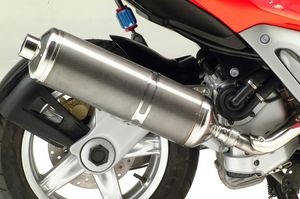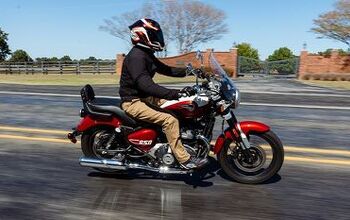2003 Piaggio Beverly 500 - Motorcycle.com
Pornography is a matter of geography, or so they say. Turn on Italian TV at prime time and you'll be showered with a myriad of game shows whose only purpose seems to be showing leggy go-go dancers strut their stuff in borderline X-rated fashion.
Makes you wonder if there are any TV aerials in the Vatican. Two-wheeled taste across the pond has always been different too. America might be the land of the sport bike/cruiser dichotomy but 'round here, the "high wheeled scooters" are just as popular as these naturally gifted ladies. Say what? Yep, topping the Italian hit parades you'll find unheard of names such as: Honda SH150, Piaggio Beverly 200 and Aprilia Scarabeo 200, the sales of the first two topping 20K each this year alone. They're sort of like Honda Cubs on steroids that combine almost-motorcycle-sized-wheels with 150-200 c.c. engines and auto transmissions. People commute, go shopping or even on a date on them, often leaving their hard-edged sport/touring tools at home during the week.
In any case, Piaggio's Beverly 500 does its best to convince you that you're almost on a proper bike. Pulling out from a stoplight while grabbing a nice handful has the CVT transmission keeping the revs in the sassy portion of the torque curve and a nearby Suzuki GS500 rider revving his engine noticeably in order to keep up with the Beverly 500. The taught feeling of a well-framed and suspended tool is just as reassuring as the crisp response of the engine. The last nail of this cognitive shift pierced my skull when the Beverly 500 settled on a 90 mph vibrationless cruise on Milan's Circular road, the Tangenzialle. Oh my golly!
That's as fast as I usually tour with my 850 Le-Mans! Strange world.
The idea of the scooter-motorcycle is not entirely new. Back in the 50's the inventive minds at Guzzi created the Galleto, essentially a typical Italian lightweight motorcycle engine in a scooter like enclosure and large wheels. But it wasn't a success, Vespas and Lambretas were too damn groovy and cheap for the Galleto to do well. Next chapter opens with one of Aprilia's first models, the Scarabeo 50 of the early seventies. Ever since, Aprilia has remained faithful to the high-wheeled scooter, launching the Scarabeo 125-150-200 blockbusting series in 1999. Piaggio, the mother of all scooters, jumped into the high-wheeled, 125-200 c.c., bandwagon with its Liberty 125, but a true anti-Scarbeo contender was released only last year, the Beverly 200. Both are on sale in the US of A -- have a look at www.piaggiousa.com. Now Piaggio raises the bar with Beverly 500.
Faithful to scooter fashion, the whole engine unit is enclosed by plastic bodywork, and a massive casting covers the belt/CVT final drive. The scooter theme continues with a front shield that spares you from the worst splashes as it folds before your foot toes to become a footboard. Unlike some scooters, the Beverly's got a pronounced hump running the length of its floorboard, to make room for the tubular space frame and fuel tank. But what really sets the Beverly apart are those massive, motorcycle sized tires. The front matches an early 90's sport mount for size while the rear is just one inch shy in diameter of what you'll find in a 750 cruiser. Further splitting the Beverly's personality is a seating position, which save for the forward
With such a speed potential, Piaggio couldn't skimp on other cycle components. Twin 260 mm discs are gripped by twin piston calipers, while a 240 mm disc caters to the rear. Less of a kick is the linked braking system, ala Guzzi. Meaning that the left handlebar lever operates one disc in the front and the rear one while the right lever grips the other front disc (remember, no clutch lever..). The 41 mm diameter fork cuts an imposing presence on the front end while the thin twin rear shocks and their chromed spring remind you of times best forgotten in Japanese suspension technology, at least visually speaking. As with all things Italian, a word on the design of the Beverly is due. Soft lines intersected by sharp cuts and folds, if you follow the latest from Alfa Romeo and Lancia, you'll see the connection. Chromed accents tell that the marketing gurus are targeting the Beverly at the same crowd that gets the latest, high-end mobiles from Nokia or Ericsson. Original Cool Retro Chic.
So yes, determined motorcycle riders would pass me eventually in stop lights GP's, but then, all the while I was sitting calmly with my left hand resting on my thigh while the next typical Italian macho had to sweat to keep his engine on the boil. Ever did a standing 1/4 mile under 16 seconds just by twisting your wrist? A surreal experience. Dealing with tight traffic situations was a doodle too. Some CVT equipped scooters tend to be a bit hesitant in slow speed, on- off situations, not so the Beverly 500. Short throttle bursts gave immediate response when gaps opened up or while playing feet-up trials, riding between stuck cars, this EFI is sorted out just fine. On the other hand, the motorcycle-like size of the thing means a Harley-esque, 62" wheelbase too. That doesn't mean it's heavy steering, quite the opposite, but chucking the thing around while trying to follow crazy pizza guys on nippy 50's sneaking through traffic is not really an option. The Beverly is much happier doing what it is supposed to, commuting. When the traffic flow starts to quicken and the road opens up, the Beverly shows its mantle. Keeping up and passing 70 mph traffic is quite easy and in the fast flowing Italian traffic, the Beverly keeps an 85-90 cruise speed. Well, with the claimed power that was sort of expected.
Yes, savvy readers might have heard also of that other race, the SuperScooters. Things with 500-650 cc twin engines, 50 hp, smaller wheels, weighing 100 pounds more and with a longer wheelbase still. Maybe its my motorcycling background but I never found the idea of sitting on a sofa in the open air at 100 mph too appealing. My vertebral column never really liked it and I do not yet believe in a lay-z-boy posture for good control at the speeds these tools are capable of. Just like the Italian game-show girls, the Beverly 500 treads the thinning borderline between motorcycle and scooter. Could it be enough to change American two-wheeled tastes? In case its not enough, Piaggio has under its sleeve a few other niceties coming up. A full Sports 500 Scooter with a true swingarm and monoshock suspension. Tests of a CVT equiped V-Twin engine using two top ends of the Beverly engine, have started some time ago. And if that's not enough...
Engine Single cylinder, four-stroke Piaggio MASTER
Displacement 460 cc (bore: 92 mm, stroke: 69 mm)
Compression ratio 10.5 : 1
Fuel Unleaded
Max. power output 29 kW (39 bhp) at 7,500 rpm
Peak torque 43 Nm at 5,500 rpm
Timing gear Single overhead camshaft (SOHC) with 4 valves
Cooling Liquid
Balancing Counter-rotating balancer shaft
Ignition Electronic with variable spark advance. High energy inductive
winding
Lubrication Gear-driven trochoidal pump
Electronic management system Alfa/N type with injection/ignition mapping
linked to environmental conditions
Fuel supply Magneti Marelli IAW electronic injection system
Throttle valve Throttle valve incorporating position sensor, motor
stepper and air temperature sensor
Injector Marelli pico-injector, high impedance electronic injector
Exhaust Two-stage catalytic converter
Starter Electric, with automatic choke
Transmission CVT automatic ratio variation
Clutch Centrifugal
Frame Double cradle in high-tensile steel tubes
Front suspension Telehydraulic fork, Ø 41 mm shafts
Fork axial stroke 104 mm
Rear suspension Engine acts as oscillating fork, two dual-effect
hydraulic dampers, four-position coil spring
Rear wheel vertical stroke 100 mm
Brakes Integral: left lever actions rear disk and left front disk
simultaneously for even division of braking power; right brake lever
actions right front disk
Front brakes Double stainless steel disk, 260 mm diameter with fixed
calliper and two opposed pistons Ø 32-34 mm (left and right respectively)
Rear brake Stainless steel disk, 240 mm diameter with fixed calliper and
two opposed pistons Ø 34 mm
Front wheel rim Light die-cast alloy - 16" x 3.00
Rear wheel rim Light die-cast alloy - 14" x 4.50
Front tyre Tubeless 110 / 70 - 16"
Rear tyre Tubeless 150 / 70 - 14"
Length 2,215 mm
Width 770 mm
Seat height 775 mm
Wheelbase 1,550 mm
Dry weight 189 kg
Fuel tank 13.2 litres (of which 3 litres are reserve)
Max. speed 160 km/h
Acceleration 100 m 6.6 sec
Acceleration 200 m 10.0 sec
Acceleration 300 m 13.0 sec
Acceleration 400 m 15.7 sec
Consumption at 90 km/h 3.3 litres per 100 km
Range at 90 km/h Over 350 km
Under-seat storage Half-face helmet and various objects; more space
behind front shield
Emissions European homologation: meets all chapters of Multidirective
97/24/EC (future Euro2 standards)
More by Yossef Schvetz



































Comments
Join the conversation